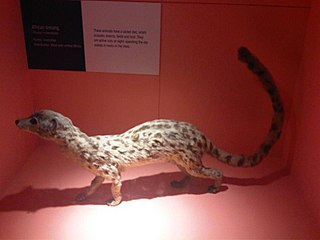
Viverridae is a family of small to medium-sized, feliform mammals. The viverrids comprise 33 species placed in 14 genera. This family was named and first described by John Edward Gray in 1821. Viverrids occur all over Africa, southern Europe, and South and Southeast Asia, across the Wallace Line. Their occurrence in Sulawesi and in some of the adjoining islands shows them to be ancient inhabitants of the Old World tropics.

A genet is a member of the genus Genetta, which consists of 14 to 17 species of small African carnivorans. The common genet is the only genet present in Europe and occurs in the Iberian Peninsula, Italy and France.

The crested servaline genet, also known as the crested genet, is a genet species endemic to Nigeria and Cameroon. As the population has declined due to loss of habitat, it is listed as Vulnerable on the IUCN Red List. It was first recorded in the Mamfe Division in Cameroon and initially considered a subspecies of the servaline genet. But now it is regarded as a distinct species.

The servaline genet is a genet species native to Central Africa. As it is widely distributed and considered common, it is listed as Least Concern on the IUCN Red List.

The aquatic genet is a genet that has only been recorded in the northeast of the Democratic Republic of the Congo. Since it is only known from about 30 specimens in zoological collections, it had been listed as Data Deficient on the IUCN Red List since 1996, as it is considered one of Africa's rarest carnivores. In 2015, it has been reassessed as Near Threatened.

The Abyssinian genet, also known as the Ethiopian genet, is a genet species native to Ethiopia, Eritrea, Somalia, Sudan, and Djibouti. It is listed as Data Deficient on the IUCN Red List. It is one of the least-known genet species.

The Angolan genet or miombo genet is a genet species endemic to Southern Africa. It is considered common in this region and therefore listed as Least Concern in the IUCN Red List. Little is known about its ecology.

The common genet is a small viverrid indigenous to Africa that was introduced to southwestern Europe and the Balearic Islands. It is widely distributed north of the Sahara, in savanna zones south of the Sahara to southern Africa and along the coast of Arabia, Yemen and Oman. It is listed as Least Concern on the IUCN Red List.

The rusty-spotted genet, also called panther genet and large-spotted genet, is a genet that is widely distributed in sub-Saharan Africa. It is considered common and therefore listed as Least Concern on the IUCN Red List.

Johnston's genet is a genet species native to the Upper Guinean forests. As it is threatened by deforestation and conversion of rainforest to agriculturally and industrially used land, it is listed as Near Threatened on the IUCN Red List.

The giant forest genet, also known as the giant genet, is a genet species endemic to the Congo Basin. As it is considered as widely distributed and common, it is listed as Least Concern on the IUCN Red List.

The Cape genet, also known as the South African large-spotted genet, is a genet species endemic to South Africa. As it is common and not threatened, it is listed as Least Concern on the IUCN Red List. Like other genets, it is nocturnal and arboreal, preferring to live in the riparian zones of forests, as long as these are not marshy areas.

The Hausa genet is a genet species native to West African savannas. It is listed as Least Concern on the IUCN Red List.
The Zanzibar servaline genet is a recently discovered subspecies of servaline genet endemic to Unguja Island in the Tanzanian archipelago of Zanzibar. Its conservation status is uncertain.

The Central African oyan, also called Central African linsang, is a linsang species native to Central Africa.

The Hottentot golden mole is a species of mammal in the golden mole family, Chrysochloridae. It is found in South Africa, Eswatini, and possibly Lesotho. Its natural habitats are temperate forests, subtropical or tropical dry forest, subtropical or tropical moist lowland forest, dry savanna, moist savanna, subtropical or tropical dry shrubland, Mediterranean-type shrubby vegetation, temperate grassland, subtropical or tropical dry lowland grassland, subtropical or tropical high-altitude grassland, sandy shores, arable land, pastureland, plantations, rural gardens, urban areas, and introduced vegetation.

The Viverrinae represent the largest subfamily within the Viverridae comprising five genera, which are subdivided into 22 species native to Africa and Southeast Asia. This subfamily was denominated and first described by John Edward Gray in 1864.

Bourlon's genet is a genet species native to the Upper Guinean forests. It is known from only 29 zoological specimens in natural history museum and has been described as a new Genetta species in 2003. It is listed as Vulnerable on the IUCN Red List as the global population is estimated at less than 10,000 mature individuals.

The pardine genet, also known as the West African large spotted genet, is a genet species living in West Africa. As it is widely distributed and common, it is listed as Least Concern on the IUCN Red List.
















